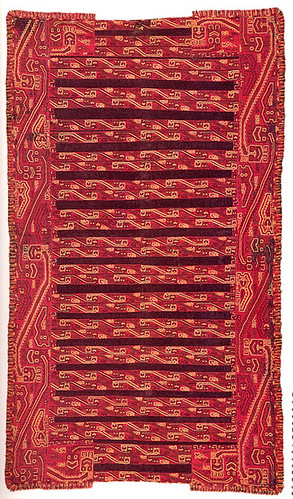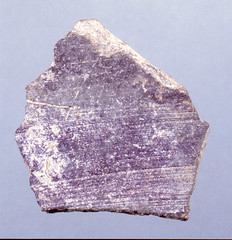Royal Purple
The Dye of Gods and Kings

Paracas (Peru) mantle, ca. 200 B.C. – 200 A.D., dyed with molluscan purple.
My interest in the Phoenicians was especially piqued when amphora fragments, covered with an intense purplish coloration on their interiors, started turning up in the 13th century B.C. levels of the Sarepta (Lebanon) excavations. At another site, such sherds might be taken as a matter of course, perhaps due to staining by a manganese ore or an exotic fungus. But when you find them at a homeland Phoenician site, thoughts turn to the celebrated Tyrian or Royal Purple dye, which was worth more than its weight in gold and became the prerogative of priests and kings.
Even the names “Canaan” and “Phoenicia” likely derive from roots meaning “red” or “purple,” underlining the importance of dyed textiles in these societies. According to Greek legend, repeated by later writers, the dye was discovered by the Tyrian high god and king, Melqart, when he and the nymph Tyros went for a stroll on the Mediterranean beach with their dog. The dog chased ahead and bit into one of the mollusks that must have once littered the shore. It came back to its master, muzzle dripping with a purple substance. The discovery was not lost on Melqart, who immediately dyed a gown with the dye and presented it to his consort.
In fact, the first foray of our laboratory into what has been called biomolecular archaeology, so-named because it focuses on ancient organic compounds, was to put the Melqart legend to the scientific test. By applying a battery of analyses, we conclusively showed that the purple color inside the Sarepta amphoras was true molluscan Royal Purple or 6,6′-dibromoindigo.
This compound is produced in nature only by three Mediterranean species of Murex and Thais, as well as related mollusk species around the world. When the purple-colored sherds at Sarepta were found to be associated with piles of shells, special processing vats and heating facilities, we had an open-and-shut case for a purple-dye factory and the earliest evidence of Royal Purple. And like the legend claimed, it was from Phoenicia or more accurately, Canaan, as the region was known in the 13th c. B.C. Other piles of the same mollusks have been found elsewhere in the Mediterranean, but so far earlier evidence for intentional dye production, as would be evidenced by a factory or actual dyed textiles, has not emerged. The discarded shell piles elsewhere could represent the debris after eating the animals or stockpiling them for pottery or plaster manufacture.
Purple dyeing was also discovered by humans living and on the western and eastern shores of the Pacific Ocean in China and Peru, most likely independently of the Canaanites or Phoenicians. Species related to the Mediterranean mollusk there can also yield the color. Beginning as early as 1500 B.C. in the Mediterranean region, probably somewhat later in China, and about 700 B.C. in Peru, human beings discovered that by extracting the glandular contents in quantity and exposing the liquid to light and air, they were able to produce this unique color. Because it requires as many as 10,000 animals to produce a gram of the dye, it was also very expensive to make. In each civilization, the molluscan Purple dye eventually came to be associated only with the highest political authorities and was imbued with special religious significance. Kimonos were dyed entirely in Purple, and the extremely well-preserved textiles of the Paracas and Nazca cultures of Peru and northern Chile exhibit stunningly beautiful patterns in Purple. In 1st century Rome, Nero issued a decree that only the emperor could wear the purple–hence, the name Royal Purple.
Some might argue that a transference of dyeing technology from a more advanced culture (e.g., the Near East) to a more fledgling one (China or Peru) accounts for the available evidence. Another scenario is more likely for this example of convergent development, in keeping with Occam’s razor or rule, viz., the simplest, most straight-forward explanation is often the right one. It runs as follows. The mollusks with the purple dye precursors were probably also a source of food in each region. The Mediterranean species, for example, are still a great delicacy in France and Italy, and the Chinese are renowned for exploiting every food source in their environment. In removing the animal from its shell and preparing it to be eaten, the hypobranchial gland, which is located on the outside of the creature, is easily broken. Once the liquid has seeped out, it will immediately begin to change from a greenish liquid to purple on exposure to light and air. A shellfish-monger’s hands would soon be covered with the purple dye, which is one of the most intense natural dyes known and can only be removed by using a reducing agent. By no great leap of imagination, the Purple began to be collected and used as a dyeing agent. While this scenario may never be proven absolutely, it accounts for the archaeological data and is in keeping with human inventiveness.
Currently, we are now analyzing a textile, which was dyed purple, from an 8th c. B.C. Phoenician shipwreck off the coast of Ashkeon (Israel). From Ashkelon proper, we are testing residues from a probable Iron IA winepress and from enigmatic underground jars and other installations of late Iron Age date that might have been used to make “grappa” or for dyeing.
P. E. McGovern and R. H. Michel
1990 Royal Purple Dye: The Chemical Reconstruction of the Ancient Mediterranean Industry. Accounts of Chemical Research 23: 152-158.
1985 Royal Purple Dye: Tracing the Chemical Origins of the Industry. Analytical Chemistry 57: 1514A-1522A.

